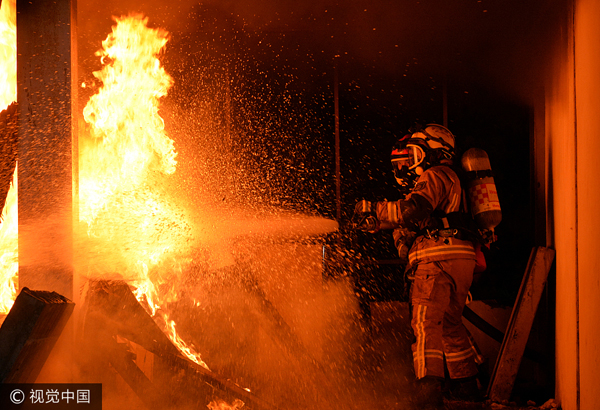
From the People’s Daily app.
This is Story in the Story.
Recently, China's Standing Committee of the National People's Congress approved its national firefighting and rescue ordinance. The move officially established a system of ranks for fire and rescue services.
In Beijing, close to 700 citizens were recruited for the city's firefighting force.
After the new recruits completed one month of training, they were dispatched to different units throughout the capital.
The firefighters signed a three-year contract with a guaranteed annual salary of 100,000 yuan.
Typically, China's firefighters have come from the Armed Police Force, men between the ages of 18 and 22 who serve two-year contracts.
The advantages are clear as militarized management leads to efficiency, but it does not mean the job is any less dangerous.
According to China's Ministry of Public Security, the average age of firefighters who died in the line of duty from 2006 to 2013 was 24.
Today's Story in the Story looks at China's firefighting force and the people who keep the city safe and protect the nation's cultural heritage.

Firefighters in action. (Photo/VCG)
Although largely unnoticed, a team of 50 firefighters stands watch in a courtyard close to the east gate inside Beijing's Forbidden City, the former imperial palace.
The unit stands watch, prepared at all times, for what is the deadliest threat to the world's biggest wooden complex: fire
Du Yandong, 28, commands a unit at the Tian'anmen Fire Squadron and has lived inside Forbidden City for almost a decade.
When he heard what happened to Brazil's 200-year-old National Museum, he was heartbroken.
"I cannot imagine what would happen if the Palace Museum caught fire. Six hundred years of our history is here," Du said.
The former Imperial Palace from 1420 to 1911 covers 720,000 square meters, and houses almost 2 million cultural relics, according to a 2016 inventory.
Fortunately, fires at Chinese museums are not common. The most recent incident happened in 1994 at a museum in Jilin Province. Two people perished, and thousands of cultural relics went up in flames.
Du commands a unit of six firefighters. Each one is responsible for a specific task.
They rise at 6 am every day and practice fire safety drills. Running along the 3-kilometer moat is first, followed by training in specific areas.
The firefighters must be able to run over 50 meters in less than 13 seconds while carrying three rolls of 20-meter-long standpipe hoses and then connect them to water hydrants.
Since the unit was established in 1970, there have been no major fires within its jurisdiction, which covers not only the Palace Museum but all of Tian'anmen Square.
In 1987, the Palace of Great Brilliance was struck by lightning and a fire ensued. The blaze was quickly extinguished before any damage came to the relics inside, but a small portion of the roof was charred.
Following this incident, lightning conductors were installed on the roof of every building in the wooden complex.

Drills are staged frequently at the Palace Museum in Beijing, where a team is stationed by the east gate to keep watch for fire in turn 24 hours a day. (Photo/China Daily)
"Any fire at the Forbidden City, which is in the heart of Beijing, would have wider implications for the public than merely being just a cultural disaster. We have to take precautions against any latent danger," Du said.
Li Yang, 31, has been with the Forbidden City fire unit for 11 years. He oversees daily inspections and emergency drills.
Li has combed through every alleyway inside, working out the best emergency escape routes.
"Roads inside the museum have various slopes and widths, and are in different states of repair," Li explained and added, "we are equipped with a variety of vehicles that can reach anywhere."
Li has received additional training to understand more about the structure's cultural heritage and ancient architecture.
There are 8,728 "rooms." Any square space with four columns is considered a room, according to Chinese tradition. Li has studied every one of them.
Depending on the fire, water is not always the best solution. Li explained that for burning timber, foam would be used to extinguish the flames.
When asked how many fire hydrants there are in the Forbidden City, Du said instantly, "167," and added, "I could not be more familiar with that number."
The squadron's jurisdiction includes other nearby landmarks such as the Tian'anmen Rostrum and the Great Hall of the People.
They also protect the National Museum of China, which houses over 1 million cultural relics and has a floor area of 192,000 square meters, making it one of the biggest museums in the world.
Du and Li have become used to their lives while many of their colleagues have transferred to other civilian work.
"This work still needs us," Li said. "It's a work of honor, which you cannot get somewhere else. The Palace Museum is my home."
(Produced by Nancy Yan Xu, Lance Crayon, Brian Lowe and Da Hang. Music by: bensound.com. Text from China Daily.)


